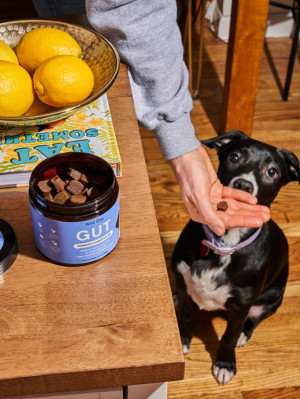Probiotics for Dogs: Benefits, Types, and When to Use Them
Should your pup take probiotics just like you do? Absolutely — but just not the same ones.
In This Article:
What Are Probiotics? Benefits of Probiotics Common Types of Probiotics How to Choose the Right Probiotics How to Administer Probiotics Side Effects and Risks of Probiotics Should I Give My Dog Probiotics?
Over the past few years, probiotics have gained increasing popularity. Not only do they benefit the gastrointestinal (GI) tract, they also aid in the treatment of other conditions. More recently, veterinarians and pet parents have come to realize there are benefits to giving dogs probiotics.
It’s helpful to understand what probiotics are, how they work, and when they may be beneficial to your dog. This knowledge can help you know which probiotic may be most helpful for your pup.
What are probiotics?
As with humans, the intestinal system of dogs contains live microorganisms. Some are good, while others are bad. Probiotics (beneficial bacteria and some yeasts) are the good ones. They support the health of the GI tract, keeping harmful bacteria in check while maintaining a balanced digestive system.
How do probiotics work in dogs?
In dogs, probiotics help maintain a healthy gut by:
Fighting against harmful bacteria that compete for nutrients
Providing substances that block pathogens
Helping digestion and nutrient absorption
Strengthening the integrity of the gut lining
Regulating immune responses
There are times when the balance between good and bad bacteria is disrupted. Factors that can contribute to this include stress, antibiotics, dietary changes, and illness. Probiotics can realign that balance.
What are prebiotics, and how are they different?
Prebiotics are not alive, but they serve as food for probiotics. Examples include inulin, fructooligosaccharides (FOS), beet pulp, and chicory root. Supplements that contain both prebiotics and probiotics are referred to as synbiotics.
Synbiotics are products or formulations that combine probiotics (beneficial live bacteria) and prebiotics (non-digestible fibers that feed those bacteria) to support gut health.
To sum this up:
Probiotics: Live microorganisms (like Lactobacillus or Bifidobacterium) that can improve the microbial balance in the gut
Prebiotics: Dietary fibers (such as inulin or fructooligosaccharides) that act as food for these beneficial microbes
Synbiotics: Combine both to maximize the survival and activity of the probiotics in the digestive system
The two types of synbiotics:
Complementary synbiotics: The probiotic and prebiotic work separately from each other, but together, they create a beneficial effect.
Synergistic synbiotics: The prebiotic is specifically chosen to enhance the survival and function of the paired probiotic strain. They work together by promoting a healthier balance of gut bacteria, thereby improving digestion and immune function.
Potential benefits of probiotics for dogs
Probiotics can have a wide range of health benefits for dogs, especially when used appropriately. Potential advantages include the following.
Allergy management: They can modulate the immune system to lessen immune reactions.
Oral health: They may reduce bad breath and maintain oral hygiene.
Digestive support: They have been found to improve digestion and enhance nutrient absorption, with reduced bloating and gas.
Relief from diarrhea: They offer help with diarrhea caused by stress, antibiotics, or dietary changes.
Skin health: Certain strains assist with improvements in skin conditions, such as atopic dermatitis.
Immune system support: A healthy intestinal tract helps regulate inflammation and immune response.
Behavioral benefits: Research suggests a link between the gut microbiome and mood, possibly improving anxiety or stress in dogs.
To obtain these benefits, you need the right strain. Different strains offer different benefits.
Common types of probiotics for dogs
There are many strains of probiotics used in veterinary supplements. Commonly used ones include:
Lactobacillus acidophilus: Aids in digestion and supports immunity
Lactobacillus casei: Known for improving nutrient absorption and digestion
Bifidobacterium animalis: Often helpful for diarrhea or inflammatory bowel disease
Enterococcus faecium: Helps maintain balance during antibiotic use
Saccharomyces boulardii: A non-pathogenic yeast used to fight antibiotic-related or infectious diarrhea
Bacillus coagulans: A spore-forming bacterium resistant to stomach acid
Some veterinary diets and chews also contain these strains. They’re often combined with prebiotics or other nutrients.
How to choose the right probiotics for your dog
Choosing a quality probiotic requires more than just grabbing a product labeled “for dogs.” Here’s what to look for.
Strain identification: Using the information we have provided, select a product that lists specific strains, not just a “probiotic blend.”
High CFU count: CFU stands for colony-forming units per serving. Select a product with billions of colony-forming units per serving: typically between one and 10 billion.
Survivability: Make sure the strain will reach the intestines alive.
Formulation: Consider ease of administration (powder, chew, capsule). Which is your dog going to allow you to administer?
Storage and shelf life: Some products require refrigeration, while others are shelf-stable.
Clinical backing: Focus on products tested in dogs with published studies or veterinary approval.
As a general rule, veterinary-formulated products tend to be more trustworthy and consistent in quality and dosage.
How to administer probiotics to dogs
Probiotics come in a few different forms. Consider your prior experience with your dog to decide which form to select.
Powders: This is sprinkled over a dog’s food (and is flavorless or beef/chicken-flavored). However, some dogs won’t eat their food if anything is sprinkled on it. If so, then this is not for you.
Capsules: You can give them to your dog whole, or opened and mixed with their food. If you open it, you may have the same problem as some folks experience with powders. Try wrapping the capsules in a slice of meat or cream cheese.
Soft chews or treats: These are usually tasty and convenient.
Probiotic-enhanced food: Some pet foods contain added probiotics, though their stability will vary.
Here are a few other tips.
Start with a small dose to ensure your dog will take it without developing GI upset.
If your dog is on antibiotics, make sure you give them the med and the probiotic at least two hours apart.
Follow the product’s dosing instructions or your veterinarian’s advice.
Consistency is key. Probiotics work best when given on a schedule, not randomly.
Side effects and risks to be aware of with probiotics and dogs
Probiotics are usually fine and don’t cause side effects. However, if you suddenly start giving your dog something new in too high a quantity, there can be problems. Some dogs may experience mild and temporary side effects such as:
Gas or bloating
Decreased appetite (rare)
Nausea or vomiting (uncommon)
These effects typically resolve within a few days. Use caution or consult your vet if your dog:
Has a weakened immune system
Is undergoing chemotherapy or other immunosuppressive treatments
Has a severe GI condition like inflammatory bowel disease (IBD)
Sources of probiotics
In addition to compounded probiotics (capsules, powders, chews), you can also find probiotics in fermented foodsopens in new tab, such as:
Yogurt
Kefir
Sauerkraut
Kimchi
Miso
Tempeh
So, should I give my dog probiotics?
Not every dog needs probiotics. There are specific canine conditions that can benefit most from them. These include:
Recovering from an illness
On antibiotics or just finished them
Having gas, food intolerance, or diarrhea
Experiencing digestive issues caused by stress or anxiety
Living with chronic allergies or skin problems
However, if your dog is healthy and has regular, well-formed stools, you may not need to give them a supplement each day. Occasional use is acceptable if your dog is experiencing stress or undergoing dietary changes. Always consult your veterinarian before starting any supplement, especially if your dog is on medications or has existing health conditions.
Bottom line
Probiotics can be a valuable addition to your dog’s health routine, particularly for supporting digestive health, immune function, and even mood regulation.
Not all products are created equally, so choose wisely and always look for strain-specific, veterinary-trusted formulations.
Though generally safe and well-tolerated, probiotics aren’t a cure-all. They should be used thoughtfully and in combination with a balanced diet and veterinary care.
Whether for short-term GI upset or long-term gut support, probiotics offer a gentle, natural way to promote better health.
References
Jensen, Anders P., and Charlotte R. Bjørnvad. “Clinical Effect of Probiotics in Prevention or Treatment of Gastrointestinal Disease in Dogs: A Systematic Review.” Journal of Veterinary Internal Medicine, vol. 33, no. 5, 16 July 2019, pp. 1849–1864, doi.org/10.1111/jvim.15554opens in new tab.
Wynn, Susan G. “Probiotics in Veterinary Practice.” Journal of the American Veterinary Medical Association, vol. 234, no. 5, 1 Mar. 2009, pp. 606–613, doi.org/10.2460/javma.234.5.606opens in new tab.
Yang, Qing, and Zhenlong Wu. “Gut Probiotics and Health of Dogs and Cats: Benefits, Applications, and Underlying Mechanisms.” Microorganisms, vol. 11, no. 10, 29 Sept. 2023, pp. 2452–2452, doi.org/10.3390/microorganisms11102452opens in new tab.










